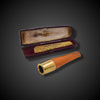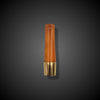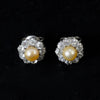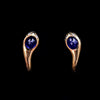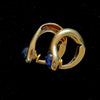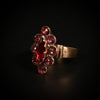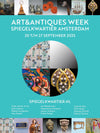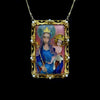For thousands of years, goldsmiths have imitated nature in precious metals and stones. This has strong connections with the oldest myths about the earthly Paradise, which featured precious stones, and as a result, kings and emperors had golden trees with precious stone leaves in their palaces, at the heart of the monarchy.
According to ancient tradition, Paradise contains trees, rivers, flowers, gemstones and pleasant scents. That represents the perfect state of the world before the first sin by Adam and Eve who ate from the forbidden tree. Gemstones were long thought to come from the 4 Rivers of Paradise.
There is nothing strange about that thought. Before gemstones were mined on a larger scale, rivers were the most important sites: alluvial deposits in gemstone language. We still call a necklace of loose, linked gemstones a river and the purest diamonds are 'like the clearest water'.
Kingship
But how are gemstones in Paradise connected to trees of gold in palaces? That has everything to do with the idea of kingship. Of course, royal power comes directly from God ("by the grace of God" is still a well-known text in modern monarchies). Like Jesus, the king was seen as God's vicar on earth. His task was to ensure peace and justice for his subjects, to strive for the situation of the earthly Paradise. Medieval crowns contained gemstones for precisely this reason: not only were they symbolic of this divine power, they were seen as the means of contacting above. After all, the heavenly Jerusalem is also built on twelve foundations of precious stones.
Constantinople
Gardens that imitate Paradise are part of all Oriental and Hellenistic traditions, often the leaves and fruits were made from precious stones such as emeralds and pearls. On the ground lay ambergris and musk: the pleasant scents of Paradise. In the Byzantine palace was the Chrysotriclinium, an octagonal hall with a dome. It was the center of the imperial cult where the entire court gathered during receptions. The golden thrones of the imperial family surrounded those of the emperor, and on the steps in front of them lay two lions of gold. In that hall were golden trees with mechanical golden birds that sang, as if they were alive.
Pape Jan
Many thought that the Garden of Eden, the earthly Paradise, was in India. When copies of the Letter from Pape John – a fictional Christian king in the Far East – became all the rage in Europe in the 12th century, Eden was said to be in Pape John's kingdom. The letter contains several descriptions of paradisiacal landscapes in which rivers filled with precious stones and of course of the jewel-encrusted palaces of Pape John. Trees made of silver, gold and precious stones played a central role in this.
The Mongol Khan
The tradition of precious metal trees in palaces also extends further geographically. In 1253, William of Rubruck and Bartholomew of Cremona arrived in the Mongolian capital of Karakorum as ambassadors of King Louis IX of France. There they met Guillaume Boucher, a goldsmith from Paris who was in the Khan's employ. Boucher had made a silver tree for the Khan's palace, with four lions at its base encircled by a gilded serpent. In the trunk of the tree sat a man blowing his trumpet, making it seem as if the angel on top was making the sound. It was the signal for alcohol to begin flowing from the lions' mouths, after which everyone could drink it. Which is also a concept of paradise, of course.
Research by Erik Schoonhoven



